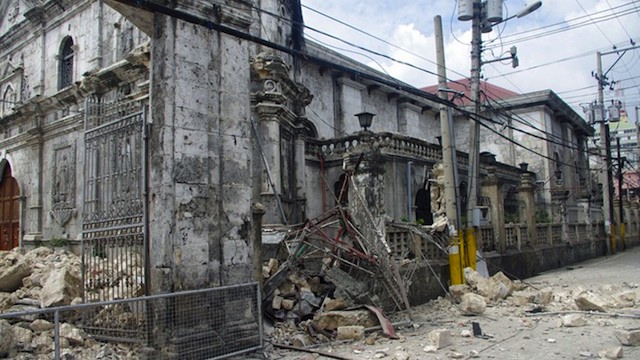SUMMARY
This is AI generated summarization, which may have errors. For context, always refer to the full article.

MANILA, Philippines (UPDATED) – The provincial governments of Cebu and Bohol placed their respective provinces under state of calamity Tuesday afternoon, October 15, following the magnitude 7.2 earthquake that struck Central Visayas.
In Cebu, the declaration was made after an emergency meeting by the Cebu provincial board hours after the quake struck the province. The tremor was centered in neighboring Bohol, but was felt across the region.
Bohol has also been placed under a state of calamity by the provincial government, provincial board member Cesar Tomas Lopez said in an interview on state television PTV4.
There is no electricity in the entire province, Lopez also said.
The government said the quake killed at least 28 people.
President Benigno Aquino III will visit the two provinces on Wednesday, October 16.
Placing a province or city under a state of calamity makes it easier for government to deliver needed services in affected areas. Calamity funds are appropriated, the prices of basic goods are frozen, no interest loans may be granted, and additional allowances are granted for government officials and disaster agencies in the area.
It struck at 8:12 am, with its epicenter in the town of Carmen, Bohol, the Philippine Institute of Volcanology and Seismology (Phivolcs) said.
Over 110 aftershocks followed the quake, according to Philvocs director Renato Solidum. No Pacific-wide tsunami thread was issued by the Pacific Tsunami Warning Center.

As of posting, at least 28 people have been reported dead in the region. Numerous structures have been damaged, including the belfry of the iconic Basilica Del Sto Niño Cebu at the heart of the capital, Cebu City.
The Basilica was first built in the 1500s by Spanish colonizers, although its current stone structure dates back to the 1700s.
There were several incidents reported in Cebu that were related to the quake, including landslides in the towns of Aloguinsan and Argo; damage in buildings in Boljoon, Tudela, Ronda and Mandaue City; and an accident in Talisay City, according to the provincial government’s tally.
Stampedes were also reported in Pinamungajan and Toledo City, as earlier reported by the Department of Social Welfare and Development (DSWD).
The stampedes occurred during the distribution of the payouts for the government’s Conditional Cash Transfer (CCT) program. One child died, and 15 others were injured in the two incidents.
Lopez said they have recorded 26 people dead across the province as of 1 pm, while 106 people were wounded.
A total of 22 churches were also damaged in the province, among them historic, centuries-old structures. – With reports from KD Suarez/Rappler.com
Add a comment
How does this make you feel?
There are no comments yet. Add your comment to start the conversation.